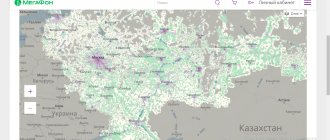I don’t know about you, but I don’t believe in stocks. Especially on the Internet.
If they came to me and offered me half a gigabit of home Internet speed, unlimited mobile Internet and digital TV “for change” for 650 rubles, then I would have twisted my head. This doesn't happen.
In Moscow, for home internet alone at a speed of 500 Mbit/sec, I pay exactly 650 rubles. Communication costs another 700 rubles per month. And one of the mobile TV services that I use rarely, but accurately (for example, I watched Khabib recently) is another 200 rubles monthly.
But it turned out that there is something much more profitable. With payment for all services at once, on one date. These are the “Combine!” tariffs. MegaFon, which are now actually distributed at a minimal cost.
When leaving the application, I thought that I would write something like a light defeat in the style of “look at how companies are fooling people again.” But in the end, I actually write ADVERTISING, because the option really works.
What is the essence of these tariffs?
As is now customary, MegaFon has combined all its key services into single tariffs. They are called “Unite!”
The essence of the tariffs is two or three different products, united by one single payment per month. This:
► Home Internet: speed from 50 to 500 Mbit/sec via regular cable. NOT GPON! You can use your own routers, which is just great, or pay an additional 55/88 rubles per month for rent. In the maximum tariff, a gigabit router is provided free of charge.
► Mobile communications: various tariffs from limited in traffic and minutes to almost unlimited (the Internet is generally completely unlimited, except for the junior tariff with 30 gigabytes). You can switch with your number or request a new SIM card.
► Mobile and home TV: set-top box for free (in some tariffs) or for 99 rubles per month, plus access to TV from any device (including through the proprietary MegaFon TV application) and browser.
All this stuff was compiled and divided into four different tariffs with one total payment per month. And they also gave me a discount on top.
Reasons for the drop in speed
A decrease in Internet access speed in MGTS may be due to various reasons:
- Problems on computers and mobile devices, network equipment, settings, user software - more than 90%.
- Failures in the operation of communication lines, routers, servers in external networks - about 5%;
- Problems with network equipment, lines and MGTS servers – about 5%.
Deviation of speed from the declared one is also possible due to overload of the provider's lines and servers (during peak hours, especially in the evening).
The reason may also be losses during data transmission in the network (especially typical for “copper” highways). In the latter case, the difference between the measured and declared speed, as a rule, does not exceed acceptable limits.
If you sign up now, you get a 50% discount for three months
Screenshot from MegaFon website.
Honestly, I wouldn’t even pay attention to the tariffs - there is too much other news and work right now. But when I saw a promotion for three months at half price for any of the options, and even from a major operator...
It turns out that, say, in Moscow (prices and conditions may be different in the regions), you will pay not 650 rubles for the basic tariff, but only 325 rubles. With the top one, the savings in rubles will be even more noticeable - the same 650 rubles, but with a discount.
Double discount for three most important (okay, two most important, TV - no offense) services! Great combo. Judge for yourself, here is a list of current tariffs.
Router Bandwidth
“Correct” providers, in the description of tariff plans on their websites, honestly warn that the high speeds offered can only be obtained with a direct connection - when the provider’s cable is connected to the Ethernet port of a PC or laptop. The fact is that home routers not only cut speed by distributing it between devices connected to the network, they are also limited to a throughput of 300 Mbps. This is the maximum speed that a budget router can theoretically handle. To use a tariff plan with an Internet speed of 1000 Mbit/s, you need to purchase a special powerful router that supports the corresponding speed indicator. And such routers are an order of magnitude more expensive than simple models.
It is also necessary to understand that when operating under maximum load, the router’s resource will be exhausted faster.
Unite! Economy
Home Internet at 50 Mbit/sec, either your own router or rent for 55 rubles per month. Low speed, but sufficient for work and entertainment, except for active streaming in 4K.
Mobile communications – package of 700 minutes and 30 GB. I know from myself that this much traffic will be enough if there is unlimited Wi-Fi at work and at home.
Television includes 61 channels. You can pay an additional 99 rubles per month to rent a TV set-top box or watch from a browser and the MegaFon TV mobile application.
Not a bad basic plan if you need mobile service. Conditions are at the level of the average “limited” plan in Russia, but with home Internet and TV, which are actually a bonus.
Price: 650,325 rubles per month
When should you contact your provider?
If MGTS subscribers encounter problems with connection speed, they should contact the provider’s technical support service by calling 8 (495) 636-0-636.
It is necessary to seek the help of specialists if:
- the testing revealed a significant deviation of the access speed from that declared for the tariff used;
- all user actions to troubleshoot problems on the equipment (primarily the router) did not produce results;
- the subscriber was unable to check the connection speed, and the experience and knowledge are not enough to test the operation and correct errors in devices and software on their own.
Unite! Two Internets
This is a tariff for those who do not need TV - there is no service, but the conditions for the remaining two are noticeably better.
Home Internet is now 200 Mbit/s, which is generally enough for the vast majority for any task, from 4K streaming to gaming. You can rent a suitable router for 88 rubles per month, or use your own.
The mobile communication tariff has also become fatter: mobile Internet is unlimited (distribution too!), plus 900 minutes of calls.
An excellent rate in all respects. I would get one myself if I didn’t want even higher speeds for my home Internet.
Price: 750,375 rubles per month
Unite! Hit
There is more of everything here than in the previous one, and there is also TV. Home Internet is pumped up to 300 Mbit/sec (the router is still paid). And there are already 1300 minutes in the mobile tariff.
The TV package here is extended: 188 channels, a large selection. Renting a TV set-top box is now free. You can watch through a browser or from a smartphone.
This is almost the maximum possible, while the mobile tariff is at the level of the most expensive options in Russia. But you have to pay very little per month.
Price: 850,425 rubles per month
To summarize: is it worth switching to high-speed tariffs?
Internet with speeds above 200 Mbit/s cannot yet be considered as an urgent need of society. If not to provide acceptable speed to each user of small offices, hostels, cafes, gas stations, and other public places, switching to an expensive tariff plan may be a waste of money. Fast access to sites is also provided within the tariff with speeds of up to 100 Mbit/s. If we are dealing with a slow server, not a single high-speed tariff will help. It’s easier to contact the site owner with a request to upgrade the equipment. A high-speed tariff will not always be able to ensure the speed of downloading files from the Internet. For example, high Internet speed on the current computer will in no way solve the issue of downloading time for a file via torrent in conditions of low Internet speed of the seed seed (or intentional limitation of it in the torrent client settings).
Internet providers often use high-speed tariffs as a marketing ploy to attract customers. More precisely, to recapture them from competitors. It is very good if the provider’s website, when describing the tariffs, stipulates specific technical requirements for devices that will participate in the process of ensuring high Internet speed (in fact, what was mentioned above).
It is important to take into account that in tariff plans providers specify the wording “up to such and such a speed”, for example, “up to 300 Mbit/s”. The speeds indicated by providers in tariff plans are, as a rule, the maximum rates achieved under certain conditions. For example, not during peak hours, when the provider’s channel is not overloaded. If you decide to switch to a high-speed tariff plan, you need to check with your provider about the actual Internet speed, in particular how much it usually decreases during peak hours.
Unite! All yours
Top tariff, so there’s the maximum of everything. Home Internet – as much as 500 Mbit/sec! And they give you the router for free (I’ll tell you about it in detail in the test later).
Mobile communications are not far behind: “flagship” 2100 minutes and unlimited Internet. And there are so many channels, 250 of them. And you don’t have to pay for a TV set-top box; they rent it for nothing.
The regular price for this option is not low. But if you divide it purely by the speed of your home Internet and a mobile tariff of such a high level, then the amount seems reasonable, even profitable. Dividing it two more times, we get something unrealistic for Russia.
Price: 1300 650 rubles per month (!!!)
As you may have guessed, I decided to try the top tariff. The maximum speed of the home Internet was impressive - a great help for a ton of gadgets that regularly download firmware updates or new versions of installed applications.
What pleased me more than the speed was the price. 650 rubles for all this for three months , in one payment, with rental of all equipment, unlimited Internet on a smartphone and a bonus in the form of television... show me such prices in Russia or at least specifically in Moscow.
You won't show it, because they don't exist.
How did you connect all this stuff?
On the day I left the request, a MegaFon employee called back. They say, we received it, we can install everything for you, just choose a time.
The next day, two guys knocked on the door in the morning. They brought two boxes - a router and a TV set-top box, documents and tools. While I was filling out my passport details, the guys went to the entrance “for 20 minutes.” They were gone for an hour and a half.
It turned out that there was a terrible overabundance of providers and communications in the house. It took a lot of effort to get the cable into my apartment. At the same time, we changed the router itself in the entrance, making it more powerful. It’s probably worth saying thank you from me and the neighbors right away.
1000 Mbit/s router, which is provided by MegaFon for 88 rubles. per month or free of charge with the “Combine! All yours"
Then everything was done quickly: we inserted the cord into the laptop to check the speed (more than 500 Mbit/sec, everything is as it should be), configured the router, scanned the Wi-Fi channels in the apartment (! the first “provider” to do this!) and installed the most the "clean" one.
MegaFon's router is not locked; if you wish, you can change the settings yourself. This is a model from D-Link, has 4 LAN ports, one WAN and a USB 2.0 port for connecting external devices. Alternatively, you can safely use your own instead.
MegaFon TV set-top box costs 99 rubles. per month or free of charge from the “Combine! Two Internets" and higher.
Everything worked, the documents were checked, the SIM card was activated. We took a couple of speed measurements on my devices (iPhone, iPad, several Macs). And with that we said goodbye.
I said I would connect the TV set-top box myself. It was also very fast: I entered the phone number, connected via Wi-Fi and started using it.
The tariff was fully activated (and money was written off) the next day, at which time the speed was recorded at around 500 Mbit/sec.
Hard drive capabilities
The potential of a tariff with an Internet speed of more than 200 Mbit/s may not be realized if the computer does not have an SSD installed, but a regular HDD - a hard drive with magnetic platters. When you open sites in a browser window, their data is written to the cache, that is, downloaded to the computer’s disk. The browser cache consists of several small files, the reading and writing speed of which on HDDs, as a rule, does not even reach 1 Mb/s (8 Mb/s). HDDs can achieve speeds from 80 to 170 Mb/s (respectively, from 640 to 1360 Mb/s) only when recording files sequentially, that is, when downloading single large files from the Internet. But this is the maximum figure, which can only be achieved in certain areas (at the outer edge of the plate, where there are more tracks, which, accordingly, have more sectors). When writing large files, the average data writing speed may be even less than half the maximum possible HDD speed.
Not only HDD, but not even every SSD drive will be able to unlock the potential of a tariff with Internet speeds of more than 700 Mbit/s. If we even talk about the 1000 Mbit/s tariff, then even if you have a computer with a powerful SSD, it makes sense to pay for such a tariff, unless you have a router in the house and access the Internet from several devices.
Impressions: everything works as promised
First of all, I tested my home Internet. Logical, because this is part of the connection procedure.
iPhones catch an average of 450 Mbit/s per download across the room from the router. There is nowhere to go further, and if you stand closer, the speed almost does not rise higher.
The iMac in the other room easily carries all 500-plus Mbps through its built-in Wi-Fi module. The 16-inch MacBook produces about 450 Mbps.
The 2021 iPad Pro reaches 500 Mbit/s everywhere in the apartment, and once again I am amazed at the power of its Wi-Fi. Ping is minimal, a few m/s.
Regarding cellular communications, I’m unlikely to say anything new: for two years in a row, experts have recognized MegaFon as the fastest operator in Russia. There are both 100 and 150 Mbps on the iPhone 11 Pro Max. I am satisfied with the speed of the mobile Internet, as well as the connection.
MegaFon TV set-top box interface.
I checked TV last, since I don’t watch it myself, it’s more for my wife and son. The picture quality is good, the console itself works with slight brakes in the menu, but it doesn’t hurt your nerves. The main thing is that you can now watch programs that were broadcast a few hours ago. And there are so many channels that at some point I got tired of flipping through them.
Everything works so stably that, in general, I don’t even have anything to write about here. They delivered as much as they promised in terms of speed. And that same 50% discount was activated, as promised on the site.
This is definitely the best 650 rubles I spent in 2020.
I connected and really advise you
I am happy with the Internet, mobile tariff, even the router. TV had to go to the box office. Moreover, the connection took two days. But the main thing now is different.
Promotion with three months of 50 percent discount on any of the “Combine!” tariffs. - almost a gift. Because so much top-end Internet both at home and beyond has never cost such, I don’t hesitate to write, pennies.
650 rubles for 500 Mbit/sec at home, immediately with a router, de facto unlimited communication from MegaFon and digital TV from any device in addition (excluding traffic!) - an excellent offer. Prices seem adequate even after the discount period ends: 2-3 good services at once, in a single payment, managed in one application or personal account on the website.
(
71 votes, overall rating: 4.17 out of 5)











